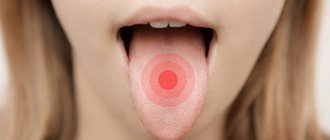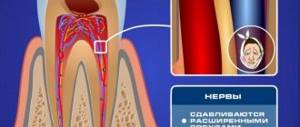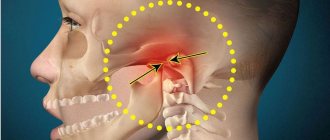Every third person experiences toothache when consuming hot and cold foods (drinks), even with careful oral care. Why do teeth react painfully to temperature changes? Is it treatable? What recommendations should you follow to avoid hypersensitivity?
The reason for the high sensitivity of teeth to various irritants (temperature, acids, etc.) is enamel hyperesthesia. It can be expressed as a short-term reaction, but more often manifests itself as a systemic disease when eating cold and hot foods.
Why does a reaction to temperature factors occur?
If the chewing front tooth aches and reacts to cold and hot, the reasons may be pathological and non-pathological. Most of them belong to the first type, since within normal limits, dental units should not respond acutely to temperature changes.
Common factors include the following:
- Diseases of the oral cavity. Caries takes 1st place in this group. Very often, people do not think about its presence until they discover unaesthetic dark spots or holes in their mouth. In the initial stages, the disease can only be diagnosed by a dentist, so it is extremely important to regularly visit the clinic for preventive examinations. In the case of pulpitis, everything is much more serious. The destruction reaches the pulp and dentin, and the nerves become inflamed. All this causes severe discomfort, which, in the absence of timely treatment, turns into acute, persistent pain. The tooth reacts to cold, feels when a person drinks hot tea, eats sweet and sour.
- Poorly performed dental intervention. Sometimes after the filling is installed, sensitivity appears. Perhaps the problem lies in poor root canal cleaning and incomplete filling. Hyperesthesia also occurs when the filling material comes into contact with hard tissues. In any case, it is important to see a doctor as soon as possible.
- The patient underwent a professional whitening procedure. The unpleasant symptom remains for several days. However, gradually the enamel layer is restored, and the discomfort disappears. If you carry out the procedure yourself without the involvement of specialists, do it too often and do not follow the recommendations, the teeth will weaken and will respond to temperature and other irritants with pain.
- Malocclusion. The chewing load is distributed unevenly, and the crowns are gradually worn away. Thanks to this, a person acutely feels any temperature changes.
- Violations of the integrity of the enamel. This is possible due to frequent consumption of hard foods, an incorrectly selected toothbrush, or mechanical impact with the formation of chips.
The problem may also be non-pathological. For example, a patient often consumes products containing aggressive acids, sugar, chemical compounds and other components that negatively affect the condition of the oral cavity.
Installing a filling after caries treatment as a problem of discomfort
Caries has two degrees of progression: chronic and acute. There are also several forms of dental damage by this pathology: deep, medium and initial.
The dentist treats deep and medium forms of lesions by mechanical treatment of the affected area, followed by installation of a filling.
If during the treatment of the tooth part of the tissue affected by caries was left behind, this may become the root cause of pain when exposed to cold.
In some dental offices, doctors use a special liquid that stains the affected part of the dental tissue with a certain color. This is very convenient, since the dentist can clearly see which area needs to be removed. But not all doctors use this drug.
In a filled tooth, pain can also be caused by other reasons, for example, improper filling procedures for deep caries. The chronic course of caries will be expressed by dense pigmented dentin, in which case the procedure for removing the affected tissue can be stopped, followed by the installation of a filling.
If the dentin is soft, the dentist may decide to strengthen it with a lining containing calcium. In this case, it does not open the tooth cavity. The infection contained in the affected bottom of the cavity gradually penetrates into the dental cavity through the dentinal canals.
Inflammation of the neurovascular bundle, accompanied by pain, is a response to infection.
The occurrence of pulpitis can be provoked by incorrect tactics of the procedure, when in the process of removing tissues affected by caries, sufficient air-water cooling of the tooth tissues was not applied. The consequence of this is heating of the pulp tissue, which provokes the occurrence and development of pulpitis.
Systemic disorders leading to hyperesthesia
Usually, its first signs appear during daily brushing of teeth. Some time after the hygienic procedure, the symptoms disappear, but this does not mean that the pathological process has receded.
If sharp pain occurs during temperature changes, it does not always indicate dental problems:
- Gastritis. The acids released from the gastrointestinal tract are caustic and negatively affect both hard and soft tissues.
- Endocrinological disorders, this also includes diabetes. There is a deficiency of vital vitamins and minerals in the body.
- Age characteristics.
- Hormone imbalance. This occurs when taking certain medications or while pregnant.
- Stressful situations, nervous shock, depression.
- Decreased immunity and accompanying inflammatory and infectious processes.
Separation of the concepts of “reaction” and “pain”
First of all, we should clearly separate the two concepts that we are accustomed to using to describe dental hypersensitivity - “reaction” and “pain”. They are very closely related to each other.
In fact, pain is the body’s reaction to various kinds of stimuli . This is a signal that allows a person to understand that there is a problem in the body, and the localization of pain indicates a specific area, the health and normal condition of which should be of concern.
That is, pain is always a reaction. At the same time, the reaction does not always manifest itself as pain.
The nature of the unpleasant sensations that arise in the teeth can be very different - from mild aching to sudden outbreaks of acute pain. A person, describing his feelings after drinking cold or hot, can use a variety of definitions.
Rationale for sensitivity
Modern clinical and scientific research has made it possible to identify the mechanisms of tooth sensitivity in different cases and situations. The results of these studies are used by both researchers and practicing dentists of most specializations.
This is due to the fact that pain is the leading characteristic symptom of most dental diseases, and its identification is very important for high-quality diagnosis .
At the moment, the temperature limits at which the tooth behaves normally, without giving any noticeable reaction, have been determined - from 10-12 to 55-65°C. This is a fairly wide range, resulting from the low thermal conductivity inherent in the hard tissues of teeth.
If an increase in their sensitivity is observed, despite the lack of innervation in these tissues, this is explained by two mechanisms:
- the first is a reflex reaction of the pulp, which has nerve structures;
- the second is the hydrodynamic processes occurring in hard tissues.
The effect of dental procedures on the sensitivity of teeth to cold and hot
Often an unpleasant symptom appears after visiting the dentist's office. In most cases, this is possible with the following manipulations:
- Professional whitening. As a result, the enamel becomes very thin. If you do it yourself at home or hire an inexperienced technician, or overuse teeth whitening, hyperesthesia will inevitably appear over time. The same applies to the use of whitening pastes, especially those containing abrasive particles.
- Installation of a seal. Incisors, canines and molars become sensitive immediately after treatment. This is a normal phenomenon that goes away in 1-2 days. There should be no acute pain, so the patient does not experience severe discomfort. If pain increases and other suspicious symptoms are present for 3 days or more, an inflammatory process may have begun, requiring urgent medical intervention.
- Prosthetics. When installing implants and prostheses, hard tissue can be damaged.
Tip #4: Strengthen your enamel with fluoride varnish and remotherapy
On this point, it is better to consult a doctor first. Why is it important? A specialist will prepare your teeth for the beneficial effects of medicinal compounds, which cannot be done at home. Simply put, the doctor will first remove all types of plaque and bacterial film. Then the useful components will fall on fertile soil and have the desired effect. Otherwise, tip number 4 will be useless.
The doctor may prescribe a course of remoprocedures (enrichment of enamel with useful minerals) and fluoridation in the dental office. It's safe and effective. The doctor may also suggest making special mouth guards in which to place medicinal compounds, and will explain how and with what frequency to use them correctly.
Fluoridation will help strengthen tooth enamel
Many people prefer not to go to a dentist for a consultation, but simply buy drugs such as Fluorlak, Remodent, and Fluocal Gel at the pharmacy. The cost of such drugs ranges from 250 to 3000 rubles. If you use them yourself, then strictly follow the instructions so as not to cause harm to your health. And be sure to read the article “6 warnings for those who want to carry out fluoridation at home.”
Why did a dead tooth begin to react to cold and hot?
Increased sensitivity occurs when nerve endings are irritated. This does not happen after extraction and depulpation. However, it often happens that a unit that is no longer alive hums, whines and causes other discomfort to a person:
- The reaction comes from healthy rows, it just seems to the patient that it is the pulpless one that is hurting. In this case, it is worth visiting a dentist to find out why this is happening. Perhaps the provoking factor was pulpitis, hidden caries or another disease.
- Poor quality treatment. It happens that even the most experienced doctor cannot cope with dental pathology the first time due to the non-standard structure of the root canals. The nerve is partially removed, some elements remain inside and cause pain. It is recommended to take an x-ray and, if necessary, treat the tooth.
- Poor quality of filling. If the filling material is applied incorrectly, inflammation occurs and acute reactions to external irritants are observed.
- Hormonal disorders, infectious diseases. These reasons are not so common, but sometimes they still occur.
When pain is normal
There are very frequent cases when the procedure for treating caries and pulpitis is carried out according to all the rules, but pain still occurs.
In this case, the cause of the pain is hyperesthesia.
Excessive sensitivity of dental tissues to various irritants is hyperesthesia.
Symptoms intensify if there are small cracks in the enamel of the teeth. Various factors contribute to the appearance of such cracks:
- Damage to the enamel from mechanical impact (hard bristles of a toothbrush, during the whitening process, due to impact or scratch with cutlery, etc.).
- Exposure of enamel tissue to aggressive nutrients (for example, citric acid).
How pain occurs
When teeth cramp and ache from cold and hot, the reaction to external stimuli can be painful. If the problem is not resolved in a timely manner, the pain syndrome will only increase, causing suffering to the patient.
The enamel gradually becomes thinner. The thinner it is, the more painful a person is from external influences. With severe destruction of hard tissues, the nerves are affected, it becomes unpleasant to eat and drink. Even a breath of wind can cause discomfort.
Classification of hypersensitivity
At the moment, there are two types of hyperesthesia: systemic (pain affects several teeth at the same time) and limited (the reaction is observed in only one tooth).
Regarding the clinical manifestations, pain of the 1st degree differs - discomfort in the presence of cold or heat. 2 degrees – increased sensitivity to thermal factors, as well as to spicy, salty, sour and sweet foods. Grade 3 – teeth react painfully to any contact with external factors.
Stages of pathology development
Symptoms are increasing every day. The less attention is paid to the prevention and care of dental units, the faster the problem will turn into incessant excruciating pain. If the tooth and gums begin to react to cold and hot, the process will develop gradually and go through the following stages:
- slight passing discomfort when eating food and drinks with very low or high temperatures;
- then there is an acute reaction to sweet, sour, too salty;
- any external irritants cause unbearable pain, even a breath of wind can provoke pain.
If you notice symptoms, you should see a dentist as soon as possible. Timely therapy guarantees a quick recovery. Otherwise, complications cannot be avoided that are difficult to treat.
Symptoms
The main symptom of tooth enamel hyperesthesia is acute short-term pain. Usually the patient complains that the tooth feels cold, sweet, hot, sour, and begins to hurt. In this case, the pain is short-lived; literally after a few seconds the pain subsides and the tooth stops hurting. The intensity of toothache can range from mild discomfort to very severe throbbing pain. In some particularly difficult cases, patients cannot even breathe in cold air and only take warm, neutral-tasting food.
Typically, pain during hyperesthesia is a constant symptom, but sometimes temporary periods of remission are observed when the teeth do not respond to stimuli at all or the intensity of pain is significantly reduced.
How is diagnostics carried out?
First of all, the oral cavity should be carefully examined by a doctor. By applying a blast of cold air or water, the dentist can test how sensitive the unit is. Then the doctor decides on the advisability of conducting diagnostic procedures. You may need an x-ray, panoramic or spot. In some cases, it is necessary to involve narrow specialists.
Help at home
An acute reaction to cold food can be dealt with using special hygiene products and folk recipes:
- Toothpastes for sensitive teeth. For example, Lacalut Sensitive, Sensodyne “Recovery and Protection”. Most often, the active ingredients in such pastes are fluoride compounds. They act on vulnerable areas of the enamel and partially restore it. Active substances form a protective barrier on crowns. Apply the funds in a course. Medicinal pastes are not suitable for regular use.
- Rinses for teeth with sensitive enamel. For example, Colgate Plax, “Healing Herbs.”
- Soft toothbrushes with atraumatic tips.
- Gels for sensitive enamel. When using the composition, a protective film is formed on the enamel. If you use the product regularly, the substances penetrate the tooth structure, restoring the top layer. The gel is applied to the crowns or trays are used. Gels are also used after dental procedures to reduce sensitivity.
- Folk remedies. To reduce the reaction to irritants, use a decoction of oak bark and chamomile infusion. Hyperesthesia is treated with tea tree oil. Add 3-4 drops of oil to one glass of boiled water. Rinse your mouth with a warm solution after each meal. The effect is noticeable after 2-3 days of treatment. If a reaction to cold occurs after eating sour food, a glass of warm milk will relieve the condition. You need to drink it slowly, holding it in your mouth.
- Soda. Add 1 tsp to a glass of warm water. facilities. The resulting solution is used to rinse the mouth.
In case of acute reaction and painful sensations, take painkillers: Ibuprofen, Ketonal, Pentalgin. They do not fight the problem, they simply temporarily relieve discomfort.
Many causes of tooth sensitivity can be quickly eliminated if you know the underlying problem of irritation and if you have the necessary remedies on hand.
Read about zirconium crowns here.
Professional treatment
Hyperesthesia is a reason for medical intervention. You should not try to cope with the problem yourself, otherwise complications will not be avoided. High-quality therapy should first of all be aimed at eliminating provoking factors.
What to do if your tooth hurts and reacts to cold and hot water, food, air:
- It is necessary to go through remineralization and fluoridation. The enamel layer is additionally fed with fluoride and calcium. A special composition with a high concentration of these components is applied to the surface. The procedures are carried out for preventive purposes to prevent caries.
- Iontophoresis involves the introduction of a special drug into hard tissues using galvanic current.
- Installation of prostheses, implantation. If the rows are very damaged, they can only be restored in this way. The doctor determines which method is optimal in a particular case: restoration with veneers, the use of composites, artificial crowns.
What to do if your teeth are afraid of cold and hot, first of all? Dentists adhere to a clear algorithm:
- initial examination and diagnosis of possible dental diseases, inflammations;
- development of a plan for further action;
- sanitation of the oral cavity and elimination of pathological foci;
- elimination of plaque and stone;
- treatment with remineralizing compounds.
Methods of dental treatment for caries
The method of treating this disease depends on its stage. Let's take a closer look at what measures are applied at each stage:
- Chalk stain. In this case, it is still possible to carry out therapy without resorting to a drill and filling. Typically, enamel remineralization is carried out using formulations with a high content of sodium fluoride and calcium gluconate.
- At the superficial stage, it may sometimes be necessary to install fillings, and remineralization of the enamel is also carried out.
- In the middle stage, it is necessary to clean carious cavities and then fill them to protect them from bacteria.
- Deep caries is treated in several stages. First, the damaged dental structures are cleaned, then a temporary filling is installed. On the second visit, if no negative reactions occur, the doctor puts a permanent filling, grinds and polishes the tooth.
A competent dentist will try to preserve the patient’s teeth while treatment is possible. He will use the removal of carious units only at such a degree of destruction of dental structures that it is no longer possible to save them.
Treatment at home
Visiting the clinic is a prerequisite for quality therapy. If it is not possible to see a doctor, you can temporarily turn to folk remedies. The following show the greatest effectiveness:
- Infusions and decoctions of herbs. Rinsing allows you to cope with the manifestations of the inflammatory process, kills bacteria, relieves swelling, and promotes rapid healing.
- Propolis. The most effective are rinses with an alcohol tincture based on this substance. However, it is important to remember that such manipulations are only allowed for adult patients. They are contraindicated for children.
- Warm milk. It is worth drinking it warm as often as possible, holding it in your mouth for a short time. Dairy products contain calcium, which has a beneficial effect on the condition of enamel.
It is recommended to use special gels and rinses designed to clean sensitive incisors, canines and molars. They contain fluoride.
But you can’t rely solely on home treatments. They can only be an addition to complex drug therapy. Even if the unpleasant symptoms have disappeared, you should not neglect a visit to the doctor.
Choosing toothpaste
When deciding what to do when teeth become sensitive to cold and hot, the dentist will first of all recommend to the patient special products for daily cleaning. Bleaching compounds should be completely abandoned, even if they do not contain abrasives.
Let's look at what you need to pay attention to when purchasing:
- Stick only to specialized paste-like and gel-like preparations. Most manufacturers put a special mark on the packaging about the purpose of the product.
- At the pharmacy you can additionally purchase medications that reduce sensitivity.
- The more fluoride a product contains, the better in this situation. The substance has a positive effect on the condition of the enamel. The hard outer layer of the units is restored, they cease to hurt and respond to stimuli.
The brush should also be suitable. Medium-hard bristles are the best option for high-quality cleaning and preventing surface scratching. But before purchasing any hygiene items, it is better to consult a doctor.
Solution
If after the filling procedure pain is diagnosed, then you need to wait 2-3 days, perhaps they will pass.
During this period, it is recommended to take painkillers with anti-inflammatory properties.
The pain does not subside after 72 hours - you should contact your dentist.
At a repeated appointment, the dentist performs the following series of actions for caries:
- Produces local anesthesia.
- Removing the seal.
- Removal of the area affected by caries.
- Reinstallation of the filling.
The stages of treatment of pulpitis (primary or repeated) are as follows:
- Administration of an anesthetic drug.
- Removing the filling and providing access to the tooth canals.
- Treatment of canal-containing areas using dental instruments with parallel exposure to an antiseptic.
- Installing a filling on a dental canal.
- Filling a tooth with a permanent or temporary filling (this is decided by the dentist).
If a doctor has installed a temporary filling for you, this means one thing - you will definitely have to visit him on the appointed day. If this is not done, the consequences may be negative.
Complications that may occur
If the problem is not eliminated in time, it will become serious and require radical medical intervention. Since in most cases sensitivity is a symptom of systemic diseases, including life-threatening ones, it must be dealt with in its infancy, without leading the situation to serious consequences.
Lack of therapy leads to severe pain. A person cannot eat normally, rest, or clean incisors, canines and molars. Even cool air entering the mouth causes pain.
In the final stages of pathology, you can notice how much the enamel is destroyed. Deep black carious cavities are observed. Sometimes the issue can only be resolved through surgery.
Tip No. 6: use herbal infusions
Herbs such as sage, chamomile and oak bark not only reduce hyperesthesia (sensitivity to various irritants), but also help strengthen the gums, increase local immunity, and fight inflammatory processes. Decoctions of the listed herbs can be used instead of store-bought rinses, but you need to prepare fresh ones every day. A warm solution of soda and water will also help relieve pain and reduce sensitivity.
Herbal tea is often used for tooth sensitivity
Prevention
Teeth hurt from temperature changes (cold and hot), but this does not mean that in order to prevent the problem, any external influence should be limited as much as possible. The modern market offers many pastes, gels, ready-made rinses and other compositions that can prevent the appearance of an unpleasant symptom or suppress it at the earliest stages. Since the composition of all products is different, doctors advise changing them periodically. In this case, it is better to exclude special bleaching agents altogether.
There are also general rules, if followed, you can protect yourself from the occurrence of hypersensitivity:
- High-quality oral hygiene. Cleaning is carried out at least 2 times a day, morning and evening. After eating, you should rinse your mouth and use floss.
- Nutrition is adjusted, it must be balanced. It is important that the foods you eat contain sufficient amounts of minerals, vitamins and other valuable components. It is recommended to limit the consumption of sweets, hard nuts and seeds, and soda as much as possible.
- Consult your doctor about possible intake of vitamin-mineral complexes.
- You should visit the dentist 2 times a year. Even if nothing bothers a person, the doctor is able to diagnose the disease at its very beginning.
What should you do if your tooth feels cold and hot, or is swollen by the breath of a chilly autumn wind or a sip of freshly prepared tea? The first thing you should do is contact a dental clinic. Only a physician will be able to carefully examine the oral cavity and identify hidden pathological processes that lead to the occurrence of increased sensitivity. Specialists will help you understand the causes of the disease and develop effective therapeutic tactics. Call or leave requests on our website.
Experts' opinion
The clinical effectiveness of Asepta products has been repeatedly proven by scientific research. For example, as part of a clinical study of the line of products conducted by Doctor of Medical Sciences, Professor A.I. Grudyanov, the high effectiveness of the Asepta mouth rinse for moderate periodontitis was established.
Research conducted at the Kazan State Academy also determined that the use of preparations from the Asepta line (gels, balms, toothpastes, rinses) makes the treatment of chronic catarrhal gingivitis and other inflammations, mild and moderate chronic periodontitis, hyperesthesia of hard dental tissues more effective , which together significantly reduces the duration of treatment and increases the duration of remission in this category of patients.
Sources:
- Study of the clinical effectiveness of treatment and prophylactic agents of the Asepta line in the treatment of inflammatory periodontal diseases (A.I. Grudyanov, I.Yu. Aleksandrovskaya, V.Yu. Korzunina) A.I. GRUDYANOV, Doctor of Medical Sciences, Prof., Head of Department I.Yu. ALEXANDROVSKAYA, Ph.D. V.Yu. KORZUNINA, asp. Department of Periodontology, Central Research Institute of Dentistry and Maxillofacial Surgery, Rosmedtekhnologii, Moscow
- The use of drugs from the Asepta line in the complex treatment of inflammatory periodontal diseases (N.V. Berezina E.N. Silantyeva S.M. Krivonos, Kazan State Medical Academy. Kazan.) N.V. BEREZINA, E.N. SILANTIEVA, S.M. KRIVONOS Kazan State Medical Academy
- Report on the determination/confirmation of the preventive properties of personal oral hygiene products “ASEPTA PLUS” Remineralization doctor-researcher A.A. Leontyev, head Department of Preventive Dentistry, Doctor of Medical Sciences, Professor S.B. Ulitovsky First St. Petersburg State Medical University named after. acad. I.P. Pavlova, Department of Preventive Dentistry
- Clinical studies of antisensitive toothpaste “Asepta Sensitive” (A.A. Leontyev, O.V. Kalinina, S.B. Ulitovsky) A.A. LEONTIEV, dentist O.V. KALININA, dentist S.B. ULITOVSKY, Doctor of Medical Sciences, Prof. Department of Therapeutic Dentistry, St. Petersburg State Medical University named after. acad. I.P. Pavlova
- https://www.youtube.com/watch?v=pkFytNfE0NM
- https://www.youtube.com/watch?v=xRPTq5y9YRQ











